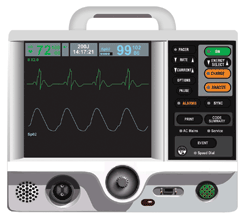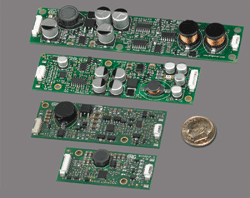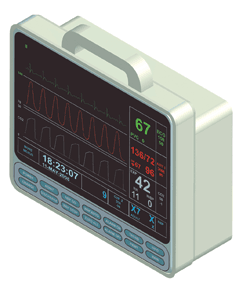Choosing display backlight units for patient monitors
Cold-cathode fluorescent lamps powered by inverters have been dominant, but light-emitting diodes are gaining ground
BY TOM NOVITSKY and BILL ABBOTT
Endicott Research Group
Endicott, NY
http://www.ergpower.com
Medical devices present special requirements for the backlight unit (BLU) of a liquid-crystal display. In all cases, the display needs to provide high-contrast, high-resolution images and data, as well as resistance to glare. For portable medical devices, the battery-powered display must provide a bright, long-lasting image. And displays in equipment used in emergency vehicles must withstand extreme temperatures and conditions that include shock, vibration, and even being sprayed with a fire hose.
It is up to the LCD manufacturer or distributor to supply a panel to the medical device manufacturer with a CCFL or LED BLU that meets application requirements. The quality of a displayed image depends heavily on the power supply to the BLU.
CCFL BLUs powered by inverters are still the most common backlighting technology for medical device displays. However, LED costs are declining, efficiencies and projected lifetimes are increasing, and the driver technology required to power them properly is in place.
CCFL backlighting
A typical medical-device display BLU uses one or two CCFLs. These small lamps provide an extremely bright, white light source to properly backlight the LCD. CCFL temperatures do not rise far above ambient, making them thermally compatible with LCD panels, since the light source may be close to other components that could be affected by excessive heat.
Depending on the application, the dc/ac inverter that powers the CCFL backlight can have an input voltage ranging from 5 to 48 Vdc. The inverter provides the high ac voltages required to light the CCFL and maintain the constant current required to control the CCFL’s brightness.
An example of the type of “intelligent” performance needed for display applications like medical monitors is the Smart Force dc/ac inverters series. These are compact, full-function devices with low profiles (
A dual-lamp version of such an inverter was selected by the manufacturer of a widely used portable defibrillator, similar to the device shown in Fig. 1 . The inverter provides constant voltage and current output over a range of input voltages so that the LCD screen maintains a constant brightness and does not change as the battery voltage changes.
The inverter automatically adjusts its output voltage and frequency as the lamp ages and changes, a key performance feature for battery-powered applications. The inverter also has higher efficiency and, consequently, less heat, than other inverter designs.


Fig. 1. A portable defibrillator of the type shown uses CCFL backlighting driven by a dual-lamp Smart Force dc/ac inverter that adjusts the BLU to optimize performance.
LED vs. CCFL performance
LEDs can provide higher brightness than CCFLs. Lower-efficiency (that is, lower-lm/W) LEDs can provide up to 20% more brightness than CCFLs. A typical increase in brightness might be 420 nits (or cd/m2 ) for an LED BLU compared to 350 nits for the CCFL BLU version for the same LCD using the same amount of power. Higher-efficiency, high-brightness LEDs (HBLEDs) can provide up to 200% more brightness than conventional CCFL BLUs, but at a higher cost.
LED backlights are typically more reliable and less fragile than CCFLs, and won’t degrade if operated for long periods of time at cold temperatures (down to −30ºC). Other advantages include higher light output for the same electrical power input and the ability to optimize color gamut. The wide range dimming capability of LEDs can be a valuable advantage, with ratios of 20,000:1 achievable. And, since LEDs contain no mercury, they provide a “green” backlight. However, these benefits come at a price, as will be discussed later.
Driving LED BLUs
An LED BLU is generally driven by a constant current; since an alternating current at high voltage isn’t required, neither is an inverter. However, LED BLUs do require appropriately designed drivers to maintain constant brightness and provide dimming. An LED’s efficiency depends on the amount of current flowing through it and, for quality performance, a constant current driver is necessary to maintain consistent brightness.
A wide variety of driver ICs are available for LED BLUs. Most employ switching and/or linear circuits to control the LED current. Depending on the configuration and number of strings, there is generally an optimum topology choice for a given display backlight. Many times, the voltage available is not usable to drive the wide array of string voltages that are required from display to display, therefore it is not possible to use the standard 5 or 12 V available with an IC to drive the backlight.
Many LED drivers employ boost or buck circuits to increase or decrease (respectively) the supply voltage, as well as a secondary circuit to directly drive the LEDs at a constant current. High-power backlights are often driven by a different topology than a lower-power backlight, as one topology may be more optimized than another for a given power level.
Along with making the correct topology choice, backlight driver designers need to be well versed in power supply layout for switching and linear circuits. The designer will also face EMI and thermal issues if the proper components are not chosen and the layout is not optimized.
Drivers must have the ability to compensate for changes in the voltage of an LED string that may occur with changing temperature or may vary with tolerances across a large number of LED backlights. This requires a full-function power supply.
Full-function LED drivers are now standard products for a broad range of LCDs, including the 6.4 to 12.1-in. sizes commonly used in medical-equipment displays (see Fig. 2 ). These compact driver boards provide wide range dimming, wide input voltages, and full brightness and enable controls. Available in a range of sizes, input voltages, and dimming ratios, they are compatible with most OEM LED-backlit panels and LED rails.

Fig. 2. LED driver boards are available as standard, “plug and play” solutions for LED-backlit displays from less than 1W up to 50W.
Thermal and cost issues
Efficient thermal management to keep the LEDs cool is a major design challenge for LED BLUs. The Smart Force LED BLU rail incorporates the LEDs on a long, narrow PC board that is thermally bonded to a metal channel or “rail”. The rail is dimensionally similar to the channel used to house CCFLs (see Fig. 3 ), but the technology used in the LED rail assembly conducts heat away from the LEDs more efficiently to maintain a low LED junction temperature.

Fig. 3. CCFL BLUs (top) are giving way to more compact and thermally efficient LED BLUs such as the rails shown on the bottom.
Switching from CCFL to LED will enhance performance, but it can also increase the backlight cost. LED BLUs using lower-lm/W LEDs can cost twice as much as comparable CCFL BLUs, while those using higher-lm/W LEDs (HBLEDs) can cost five times as much as a CCFL BLU.
There is, however, a proportional increase in brightness and reliability that can reduce energy and maintenance costs. In the case of the lower-lm/W LED, the LED BLU can provide the same brightness with 20% less power, or 20% more brightness with the same power. Using HBLEDs can provide brightness to daylight- and even sunlight-readable levels (750 to 1,500 nits and above). The high efficiency of the drivers, combined with solid thermal management, can provide LED BLU lifetimes greater than 50,000 hours. The HBLEDS can also be “tuned” to a custom brightness level, thus saving power and increasing BLU lifetime.
Driver costs for the lower-lm/W LED BLUs are comparable to costs for CCFL inverters. For example, an LED driver for an OEM LED-backlit panel that has previously used a $15 dc-ac inverter would be approximately the same. Driver costs for higher-efficiency HBLED BLUs are slightly higher.
Switching options
Users have two options in switching from CCFL to LED BLUs. One is to purchase an LED-backlit LCD from an LCD OEM. These LCDs provide slightly higher brightness than their CCFL-backlit equivalents, or reduce input power requirements for the same brightness as a CCFL. Full-function LED drivers will provide the control to optimize display operation. Another option, particularly for LCDs in the field, is to retrofit with an LED BLU. With compatible LED drivers, the LED BLU rail (Fig. 3) can be a drop-in replacement for the CCFL.

Fig. 4. Converting a CCFL-backlit patient monitor to use an LED BLU can be done in the field and provide significant performance benefits.
Recently, a major patient-monitor manufacturer was looking for replacement inverters for a portable, CCFL-backlit patient monitor (Fig. 4). When presented with an LED rail/driver that could be field-installed by their service team, the manufacturer decided to consider LED backlights now, instead of in the future, despite the higher up-front cost. ■
Advertisement
Learn more about Endicott Research Group





